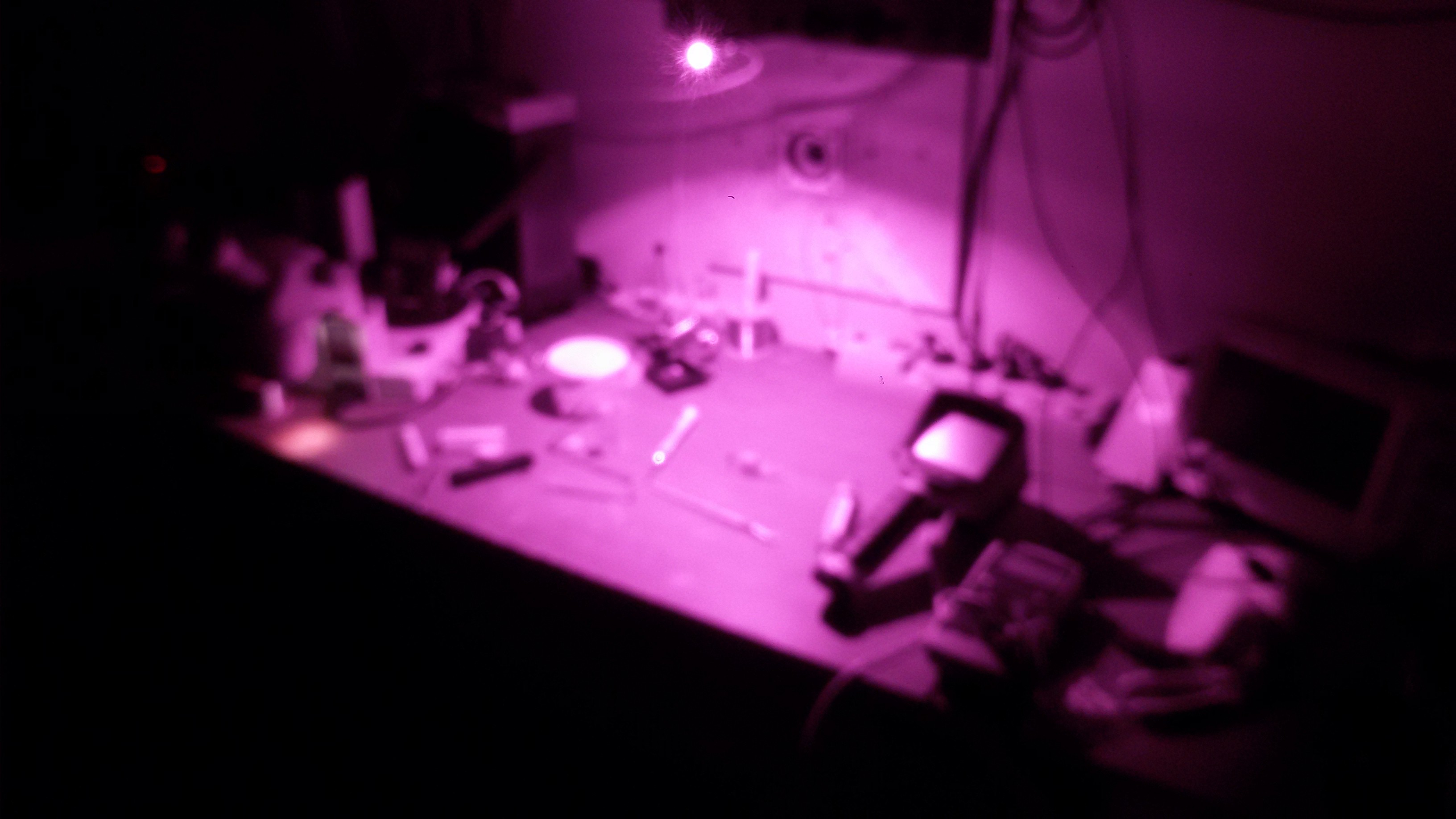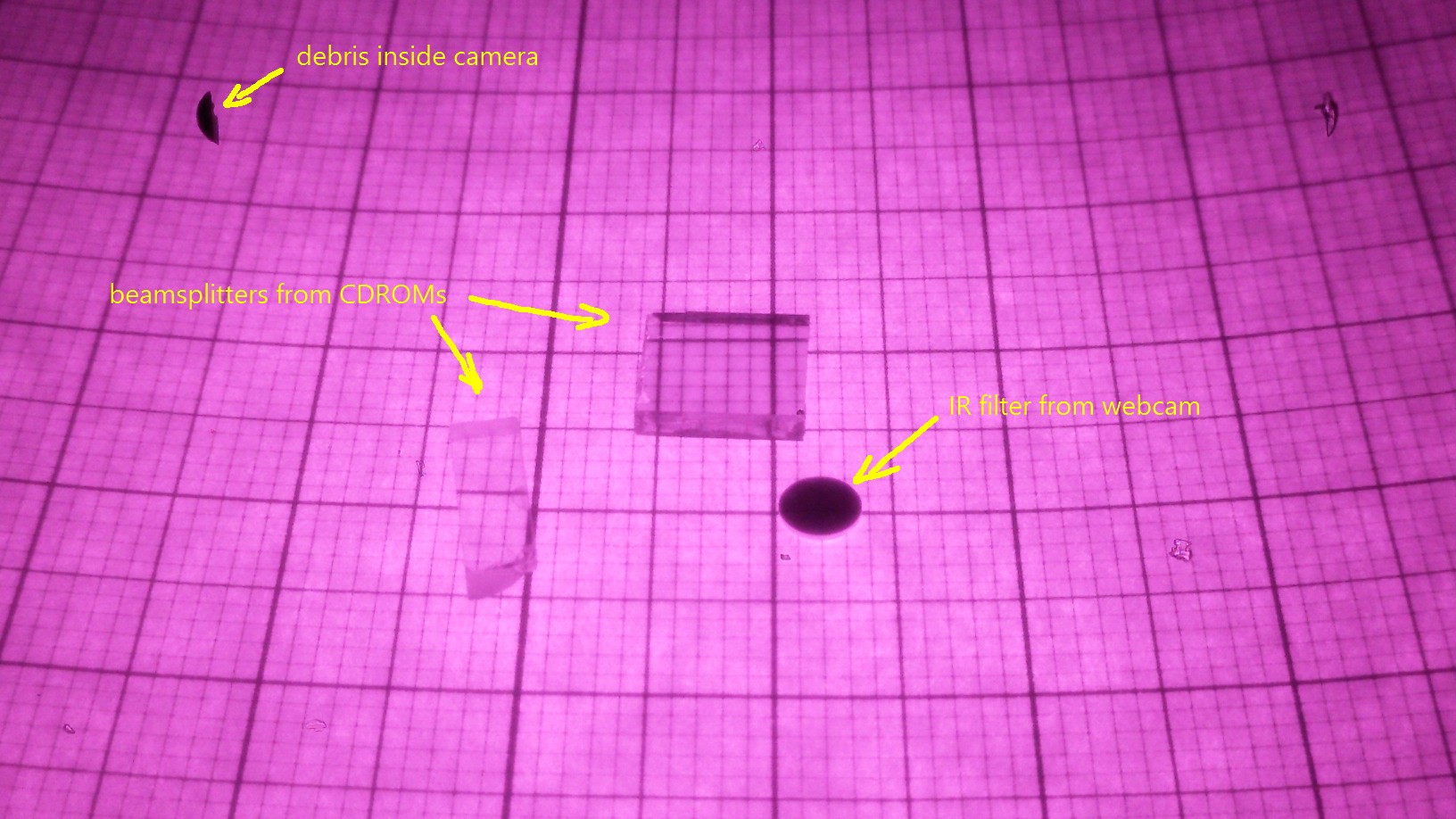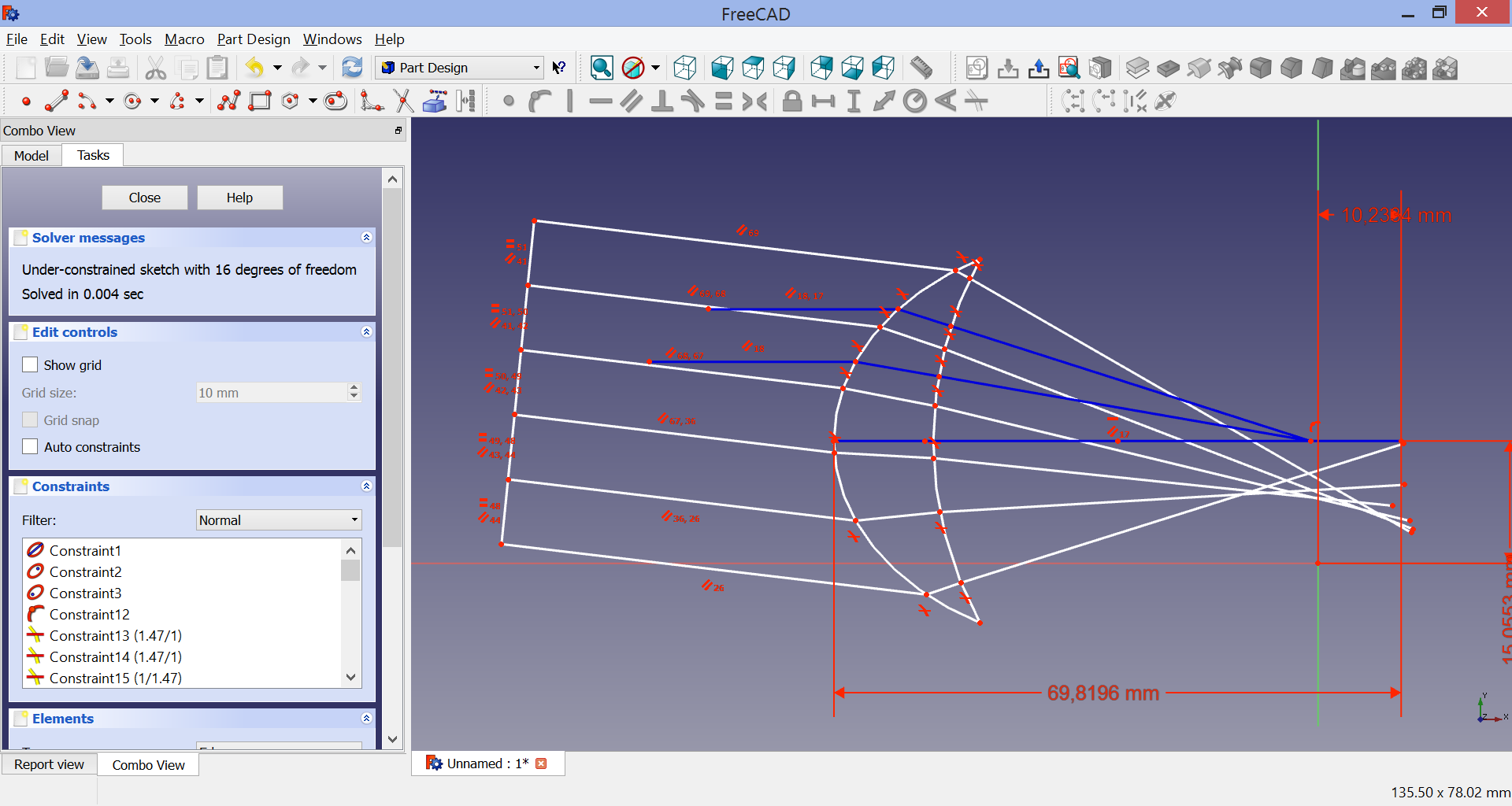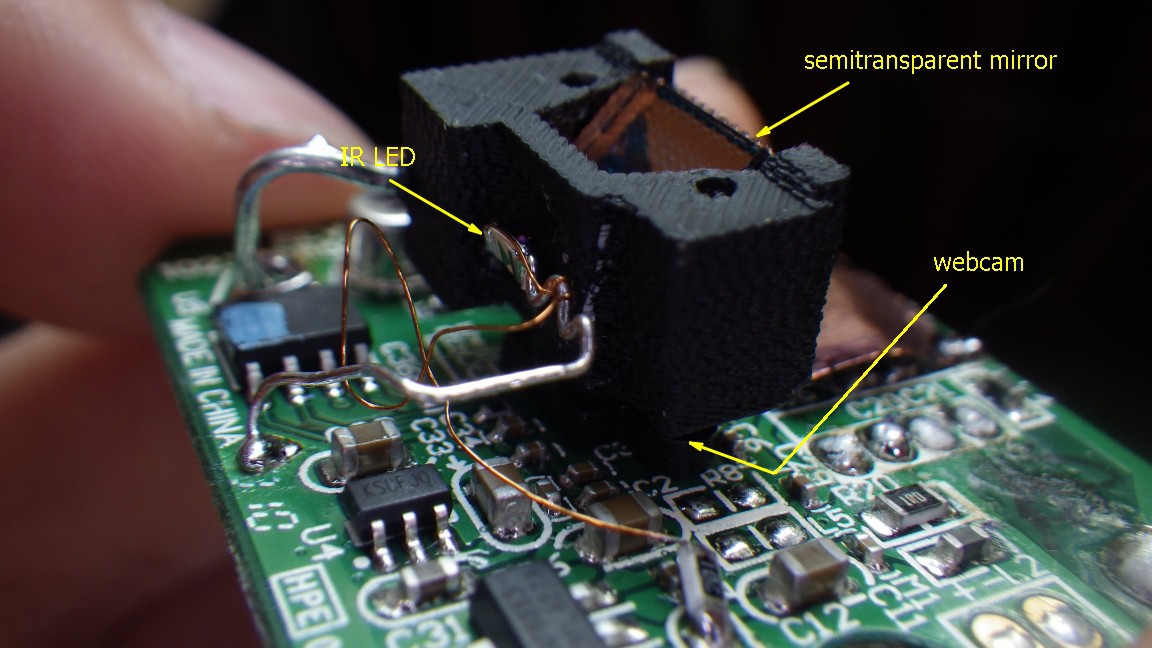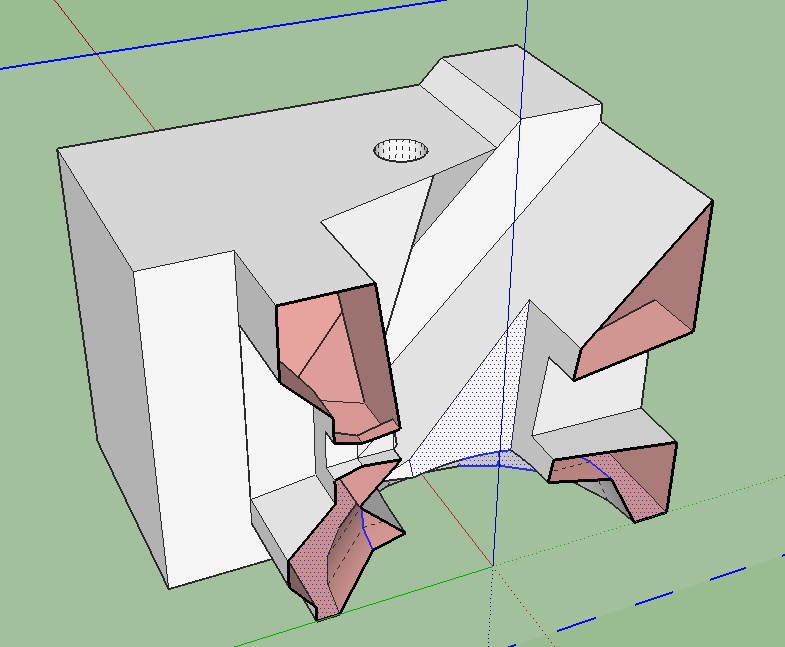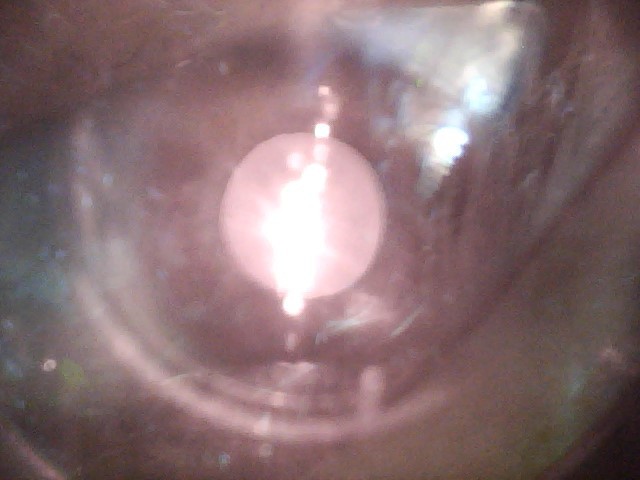-
infrared
03/07/2015 at 14:01 • 0 commentsWell, while I abandoned the project, I still have something to share.
First of all, I was busy studying my 3d printer. After realizing that the familiar SketchUp doesn't suit my needs, I switched to other CAD, and it happened to be FreeCAD.
FreeCAD is an open-source (LGPL) parametric geometry modeler, and it's super awesome because it's open-source. I've jumped in, and programmed support for Snell's law into its main 2D profile editor named Sketcher. That can seriously help with optics design. I'm very proud for that my Snell's law code was merged into main development branch of FreeCAD!
Also, I have set up some gear to aid me with infrared. The gear is just a power IR LED to light my bench, and a smartphone with a hacked camera that is able to see infrared (I just ripped IR cutoff filter off the camera).
With that setup, I made an important conclusion. All polarizers that I have (most are from LCDs, but also polarizing sunglasses and a photographic filter) are completely ineffective at near infrared (850 nm)! They just don't do anything, they are simply transparent. Surprizing, isn't it?
This means, I have to find some obscure polarizers that are specifically made for NIR, probably very expensive stuff. =(
Here are some pics made in infrared light. Some are out of focus, because I brke the focusing of smartphone's camera during surgery, and it is now fixed at focus distance of about 150 mm.
![]()
![]()
![]()
-
project abandoned
08/18/2014 at 13:54 • 0 commentsI have to admit I have abandoned the project. After the experiments I've done, I feel it's impossible to put the eye-accommodation sensor into the eyepiece. The problem of lens flare (reflections), coupled with lowness of red-eye backscatter and ridiculous size constraints imposed by space available in the eyepiece, all that makes me feel the project is hopeless. I may make another go at it in the autumn, but I'm not sure.
-
a setup with webcam
07/12/2014 at 17:27 • 0 commentsSo, this is the first time I was able to achieve a red-eye through an eyepiece! TADA!
![]()
![]()
That bright blob is strong as hell - it's the reflection off eyepiece's lens' surfaces.
But at the very least, the effect is there - it's in infrared, behind the eyepiece, and dependent on focusing (although a bit more playing is needed here). Good news!
-
culprit is found? -no =(
07/06/2014 at 19:06 • 0 commentsI was using pieces from CDROM heads for beam splitters. After a bit of googling, I've found some of them are actually polarizing beam splitters, which I was not expecting. While they are potentially very useful stuff, in my case their polarizing properties can be the reason I can't get any positive results.
UPDATE. After a bit of mucking around with polarizers, I figured out that the mirror is not at fault. While the transmitted light is indeed very polarized, the reflected one is not, I didn't notice even a tiny bit of polarization. So, while the mirror is not optimal, it is far from being the culprit.
-
having fun with my new 3d printer
06/25/2014 at 21:07 • 0 commentsit's just awesome!!! It is PrintBox3D (aka 3dadget), Russian!
3D-printing small things is a bit of an art. On the picture (left to right)
SOIC package (for scale) ; a good printout ; a not-so-good printout
-
sorry for the lack of progress,
06/24/2014 at 22:46 • 0 commentsBut there is really almost nothing to report of. Except that I have modified a couple of cameras so they are sensitive to infrared and verified that the red-eye effect is observable in infrared. It's still unclear, what wavelength I'm using, but I've ordered a bunch of IR leds for which the wavelength is specified. And a bunch of photodiodes and an amplifier.
I also plan to do some experiments with an image sensor instead of two photodiodes, to get some extra info.
-
tired of gluing random stuff together...
06/17/2014 at 22:17 • 0 comments... and waiting for a new 3d-printer to arrive. I can't live without one anymore, when every second hacker here seems to have one =)
-
idea on sensor
06/15/2014 at 17:44 • 0 commentsUp until now, most photocurrent I was getting from the phototransistor was because of the light bouncing off the lenses of the eyepiece, and probably a fair amount from reflection of the eye's sclera (the white stuff) and skin. I think these "parasitic" reflections completely obscured the signal from the red eye (obviously they are dependent on the position of the sensor). And I have a few thoughts on how to overcome this.
First. The red-eye return light is focused, while the parasitic light is not. So, if I place another photodiode close to the main one, it will receive a nearly identical parasitic light, but not the red-eye return signal. So, subtract the signals from those two photodiodes - and the signal from parasitic light is gone. That's the plan. But I have to switch to photodiodes (not phototransistors) at this point, because sensitivities must match.
Second, I should limit the cone from where the red-eye light is collected to as much close to only the eye's pupil as possible. That's not easy, but since the eye's pupil must be in quite specific position in order to see through the microscope, that is doable.
-
on IR red-eye
06/07/2014 at 22:33 • 0 commentsAfter a really lot of googling, I have found some info. I don't know the part number of the optointerrupter I'm using, but 3 randomly picked datasheets were for ones working at 940 nm. Thanks to the info on this page, I know that this wavelength falls onto the onset of eye's opacity. That shouldn't be a problem, but shifting to 850 nm is desirable. It seems that most eye-exploring istruments work at 850 nm.
Second is that the red-eye peak seems to be small enough to be completely obscured by the changes in reflections off lenses and white portions of the eye caused by movement of the detector. So, I probably have to get rid of them somehow... Maybe, doing some calculations will help to figure out by how much I have to suppress unwanted reflections.
-
close to losing hope
06/06/2014 at 21:59 • 0 commentsThe new sensor just does not seem to get anything. As before, everything is brilliant on lens+palm system, but des not work completely with the real eye. Something must be completely wrong, I have no idea what exactly =(
Update: there might be a small chance that some of the structures of the eye that are transparent to visible light are not transparent in the near infrared that I'm using. Or the infrared light is not backscattered by retina. So, I'll probably try making a sensor based on visible light.
Anyway, I wont be able to work on the project during next week, but I'll continue thinking.
 DeepSOIC
DeepSOIC